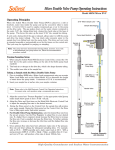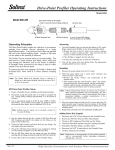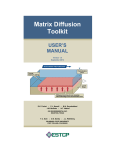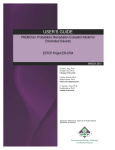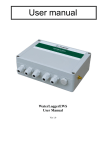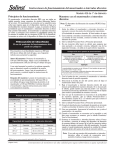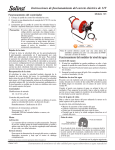Download Interface Meter Operating Instructions
Transcript
Interface Meter Operating Instructions Model 122 Operating Principal Field Measurements The Solinst Model 122 Interface Meter has a narrow 5/8" (16 mm) diameter probe. It is CSA approved for use in hazardous locations Class 1, Groups C & D. It has an infra-red circuit which detects the presence of a liquid. A conductivity circuit differentiates between conductive liquid (water) and non-conductive liquid (LNAPL or DNAPL product). Equipment Check Before beginning any measurements, check the electronics and battery condition by pushing the 'Start' button. A brief tone and red light indicate that the meter is functional. A flashing green light indicates the meter is on. It will automatically turn off after 10 minutes to preserve battery life. Using the Tape Guide 1. The tape guide has been designed to: improve accuracy when reading interface measurements; to prevent tape being cut by well casing; and to allow the tape and probe to hang straight from the side of the well. 2. If interface measurements are being taken in a 2” dia. well then simply fit the small end of the tape guide onto the edge of the well casing. 3. The small end must be inserted if the Interface Meter is to be suspended from the tape guide. 4. Insert the leg of the Interface Meter into the hole on the Tape Guide. 5. Once inserted, rest the Interface Meter on the side of the well casing. Tape Guide Measurement point Fit onto well casing Insert Interface Meter leg through hole PRODUCT: Steady Signals WATER: Intermittent Signals LR88701 Exia. Class 1, Groups C and D. Temperature Code T3C. Max. ambient 50 deg C. INTRINSICALLY SAFE WARNING: Substitution of components may impair intrinsic safety. CAUTION: This device must be grounded before introduction into the tank and remain grounded until after complete withdrawal from the tank. Tape Guide: prevents tape from scraping the top edge of well casing Model 122 Solinst Canada Ltd. http://www.solinst.com Tel: +1(905) 873-2255 (800) 661-2023 REPLACE BATTERIES in non-hazardous area. Use two 9V alkaline batteries: Duracell MN1604 or Eveready 522. Made In Canada Interface Meter ON START OFF Interface Meter: anchored to the well casing with the tape guide for stable operation. High quality medium density polyethylene tape: hangs straight in the well for accurate interface measurements. Notes: • When using the tape guide, the measuring point is offset from the top of casing • To adjust your measurements, simply subtract the amount indicated on the front of the tape guide (eg. 6 cm or 2/10 ft.) IMPORTANT 1. To meet safety requirements and to protect the electronics from damage, always ground the meter by attaching the grounding clip to the well casing or to a suitable ground rod. 2. Push the 'Start' button. A brief tone and light indicate that the meter is functional and the flashing green light indicates that the meter is on. The meter automatically turns off after 10 minutes. Press the 'Start' button as necessary during operation to turn the meter back on. 3. Place the slotted part of the tape guide onto the edge of the well casing. Lay the Interface Meter tape into the groove on the top of the tape guide. Measurements will be read at the apex of the V-notch on the tape guide. Note: When using the tape guide, remember to subtract the compensation factor stamped onto the side of the guide from each measurement. 4. A steady tone and light indicates a non-conductive liquid (eg. product). An intermittent tone and light indicates a conductive liquid (eg. water). 5. For floating product (LNAPL), take the air/product interface measurement on the way into the liquid, and the water/product interface on the way up. When passing through product into water, some product may adhere to the probe sensors due to surface tension. Therefore, when water is detected below product, the probe should be raised and lowered rapidly in a short vertical motion to remove any product that may have been carried down with the probe. 6. The water/product interface should then be measured as the probe is raised very slowly back up. Once the interface is detected the probe can be raised and lowered in small increments to precisely determine the interface. 7. Repeat measurements to confirm water/product interface. 8. To determine the thickness of product, subtract the water/product interface from the product/air interface. 9. To determine if there is any sinking product (DNAPL) in the well, continue lowering the probe slowly. If steady signals activate, determine the top of the sinking layer by reading directly from the tape. Continue lowering the probe slowly until the tape slackens when the well bottom is reached. Read the level directly from the tape and subtract one from the other to determine thickness. 10. Upon completion of readings clean the tape and probe; as described overleaf. Cleaning and Maintenance • After each use, the tape should be wiped clean and carefully rewound onto the reel. Battery Replacement The probe should be cleaned as follows: • Wash probe thoroughly with a non-abrasive mild detergent. DO NOT USE ANY SOLVENTS. Use a soft cloth around the pins on the end of the probe to remove all product. For the P2 Probe use the brush provided through side and base holes to remove all product from inner part of the probe. USE LUKE-WARM, NOT HOT WATER. DAMAGE TO PROBE MAY RESULT. • Rinse probe thoroughly with distilled water, wipe dry • Return the probe to the holder Other suitable cleaning method: Steam clean tape only Push battery drawer in and up and then release. The battery drawer should eject slightly, allowing it to be pulled out. Replace the two 9V batteries with alkaline batteries. Other General Tips: 1. 2. 3. 4. Probe should be cleaned after each use. Always use grounding cable Do not drop probe: damage to probe tip may result. If battery is weak, the start tone will not sound, and flashing “green” light will be off. Replace both batteries. 5. Before storage, make sure the meter is turned off. Troubleshooting Instruments will not turn on: 1. Replace batteries. 2. Check the polarity of the batteries are correct in the battery drawers. 3. Check 12-pin connector inside reel for loose wire/pin. Access by removing three screws on faceplate. Ensure instrument is laying on its back frame so the tape does not unwind. 4. Push button could be faulty, please contact Solinst. Instrument turns on, but immediately shuts off, or instrument does not shut-off, except after 10 min, automatic shutdown: 1. Check batteries, replace if necessary. 2. Dirt or debris may be causing the on/off buttons to stick. Use short blast of air to try to free up buttons. 3. Check 12-pin connector inside reel for loose wire/pin. Access by removing three screws on faceplate. Ensure instrument is laying on its back frame so the tape does not unwind. 4. Push button could be faulty, please contact Solinst. Instrument does not detect liquid: 1. Check batteries, replace if necessary. 2. Clean probe tip-follow Cleaning/Maintenance Instructions. 3. Reel or probe circuitry could be damaged, please contact Solinst. Printed in Canada 10/02 Model 122 Page 2 When instrument is turned on, it immediately sounds product tone or water tone: 1. Probe optical sensor may be dirty. Clean according to Cleaning and Maintenance instructions. 2. Possible weak batteries, replace both. 3. Water has leaked into the probe. Remove three small screws and slide the probe down from the tape portion (remember polarity of the green and white wire). Dry out probe, wipe and inspect o-ring, replace if necessary and/or lubricate with silicon grease. Replace probe remembering polarity. 4. Check 12-pin connector inside reel for loose wire/pin. Access by removing three screws on faceplate. Ensure instrument is laying on its back frame so the tape does not unwind. 5. Reel or probe circuitry could be damaged, please contact Solinst. Chirping or ‘Warbling’ sound being emitted: 1. Clean probe. 2. Possible water in probe (see troubleshooting under ‘When instrument turned on, instrument emits product or water tone’). 3. Reel or probe circuitry could be damaged, please contact Solinst. Instrument detects “product” as “water”. 1. Thoroughly dry the stainless steel shroud covering the probe tip. 2. Product may have degraded; if it has a detectable level of conductivity it will read water. This can be checked by placing the probe in pure phase product, a steady tone & light should be observed. For further information contact: Solinst Canada Ltd. Fax: +1 (905) 873-1992;(800) 516-9081 Tel: +1 (905) 873-2255;(800) 661-2023 35 Todd Road, Georgetown, Ontario Canada L7G 4R8 E-mail: [email protected] Web: http://www.solinst.com



